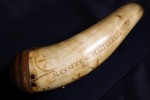 A powder horn engraved with Alexander Hamilton’s name that most likely belonged to the Founding Father himself is going up for auction next month. The seller is dentist Dr. Warren Richman who bought it from a patient in 1990. He has spent decades documenting the artifact, trying to find conclusive evidence that it belonged to the man whose name is on it not once but twice. An arms appraiser, a forensic documents expert and Alexander Hamilton’s great great great great great grandson Douglas Hamilton all agree that it’s the real deal. They believe he carried gun powder in it when serving under General George Washington during the Revolutionary War and that the carving was done by Hamilton’s own hand.
A powder horn engraved with Alexander Hamilton’s name that most likely belonged to the Founding Father himself is going up for auction next month. The seller is dentist Dr. Warren Richman who bought it from a patient in 1990. He has spent decades documenting the artifact, trying to find conclusive evidence that it belonged to the man whose name is on it not once but twice. An arms appraiser, a forensic documents expert and Alexander Hamilton’s great great great great great grandson Douglas Hamilton all agree that it’s the real deal. They believe he carried gun powder in it when serving under General George Washington during the Revolutionary War and that the carving was done by Hamilton’s own hand.
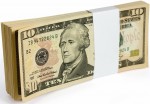 Born in Charlestown, the capital of the island of Nevis in the British West Indies, the illegitimate son of Rachel Faucette Lavien, an unhappily married woman who had fled her husband, and James Hamilton, one of many lesser sons of British nobility who had left home to seek his fortune in the Americas, Alexander was abandoned by his father and two years later lost his mother to fever when he was 11 or 13 years old. (His year of birth is uncertain, either 1755 or 1757). Young Alexander was left with nothing but a couple of dozen books, so he went to work as a clerk for an American shipping company. The future Secretary of the Treasury, founder of the Bank of New York and engineer of a new country’s monetary system, was so good at the business that he was left in charge of the firm for five months in 1771 while still a teenager.
Born in Charlestown, the capital of the island of Nevis in the British West Indies, the illegitimate son of Rachel Faucette Lavien, an unhappily married woman who had fled her husband, and James Hamilton, one of many lesser sons of British nobility who had left home to seek his fortune in the Americas, Alexander was abandoned by his father and two years later lost his mother to fever when he was 11 or 13 years old. (His year of birth is uncertain, either 1755 or 1757). Young Alexander was left with nothing but a couple of dozen books, so he went to work as a clerk for an American shipping company. The future Secretary of the Treasury, founder of the Bank of New York and engineer of a new country’s monetary system, was so good at the business that he was left in charge of the firm for five months in 1771 while still a teenager.
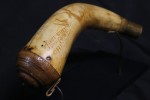 Alexander Hamilton had other unmistakable gifts as well. He wrote an account of a hurricane published in the Royal Danish American Gazette that so impressed community leaders they raised money to send him to the North American colonies to advance his education. Hamilton arrived in New Jersey in 1772 and, after a year of college preparatory studies, enrolled at King’s College (modern-day Columbia University) in New York City in the fall of 1773.
Alexander Hamilton had other unmistakable gifts as well. He wrote an account of a hurricane published in the Royal Danish American Gazette that so impressed community leaders they raised money to send him to the North American colonies to advance his education. Hamilton arrived in New Jersey in 1772 and, after a year of college preparatory studies, enrolled at King’s College (modern-day Columbia University) in New York City in the fall of 1773.
He quickly became involved in the hot political topic of the era and earned a reputation as a lucid and effective advocate for the patriot cause. When armed conflict broke out between the British Army and colonials at the Battles of Lexington and Concord in 1775, Hamilton volunteered for the New York militia. This is the fulfillment of a long-hold wish expressed in a letter to his friend Edward Stevens when Hamilton was just 14 years old and clerking for food:
To confess my weakness, Ned, my ambition is so prevalent that I disdain the groveling conditions of a clerk to which my fortune condemns me. I would willingly risk my life, though not my character, to exalt my station. My folly makes me ashamed, yet Neddy, we know that such schemes can triumph when the schemer is resolute. Oh, how I wish there was a war!
That deep drive to rise up in the world, to make something of himself, to fight in a war which affords men of talent and bravery the chance at field promotions, medals and fame explains the alacrity with which he joined the Revolutionary cause. It also explains some of the engraving on the powder horn.
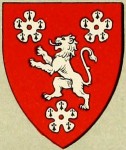
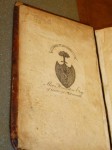 Alexander’s father James was the fourth son of Scottish nobleman Alexander Hamilton of Grange, and the younger Alexander proved keen to affirm that connection throughout his life. He wanted to have his never-legitimized heritage publicly recognized. He put the coat of arms and crest of the Grange branch of the Hamiltons on his personalized bookplates. He named his house in New York The Grange after the family seat.
Alexander’s father James was the fourth son of Scottish nobleman Alexander Hamilton of Grange, and the younger Alexander proved keen to affirm that connection throughout his life. He wanted to have his never-legitimized heritage publicly recognized. He put the coat of arms and crest of the Grange branch of the Hamiltons on his personalized bookplates. He named his house in New York The Grange after the family seat.
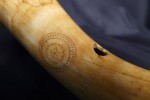 The powder horn has multiple elements of the arms of the Hamiltons of Grange. There’s a unicorn — the symbol of Scotland also seen in several Hamilton crests — with a five-petaled flower on its hip. The more stylized, geometric version of a five-petaled flower, the cinquefoil, is on the Grange coat of arms. A roundel engraved on the horn has that formal version of the cinquefoil. It’s too faded to be sure, but it looks like it’s not just a plain cinquefoil, but a cinquefoil ermine (dotted with black shapes that represent the black-tipped tail of the winter stoat). The Hamilton of Grange arms use cinquefoil ermine.
The powder horn has multiple elements of the arms of the Hamiltons of Grange. There’s a unicorn — the symbol of Scotland also seen in several Hamilton crests — with a five-petaled flower on its hip. The more stylized, geometric version of a five-petaled flower, the cinquefoil, is on the Grange coat of arms. A roundel engraved on the horn has that formal version of the cinquefoil. It’s too faded to be sure, but it looks like it’s not just a plain cinquefoil, but a cinquefoil ermine (dotted with black shapes that represent the black-tipped tail of the winter stoat). The Hamilton of Grange arms use cinquefoil ermine.
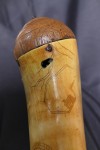 Other engravings aren’t necessarily specific to the Hamilton family but are very much in keeping with Alexander’s yearning to make it big. There’s an engraving of a large house with a large enclosed property and several forking streams, symbolizing landed wealth. Another roundel holds a group of fasces, the tied bundle of wooden rods that in Ancient Rome represented magisterial authority.
Other engravings aren’t necessarily specific to the Hamilton family but are very much in keeping with Alexander’s yearning to make it big. There’s an engraving of a large house with a large enclosed property and several forking streams, symbolizing landed wealth. Another roundel holds a group of fasces, the tied bundle of wooden rods that in Ancient Rome represented magisterial authority.
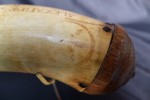 The year engraved on it is 1773, the year Hamilton went to King’s College. Carving your name and symbols on a power horn in anticipation of a war that hasn’t started yet sounds like a studenty thing to do, especially a student who had openly yearned for war when he was barely into his teens.
The year engraved on it is 1773, the year Hamilton went to King’s College. Carving your name and symbols on a power horn in anticipation of a war that hasn’t started yet sounds like a studenty thing to do, especially a student who had openly yearned for war when he was barely into his teens.
One engraved phrase is odd, though. It reads: “First When When [sic] Came To Ohio.” The auction catalogue says it’s a “reference to American settlement,” which okay, but really? Why? Why wouldn’t it be “First When Came To New Jersey” or “First When Came To New York”? The extra word doesn’t bother me — he made other mistakes in the carving, like not leaving enough room for the final r on the large engraved “Alexander.” Ohio, not one of the 13 colonies, was a British territory until after the war. The first US settlers of Ohio were Revolutionary War veterans who founded the city of Marietta.
Authentic powder horn of Alexander Hamilton or no, it is estimated to sell for $25,000 – $35,000 and the starting bid is $10,000. The auction is on January 11th.
“Ohio” probably had a symbolic significance that went beyond a youthful Hamilton’s daydreams.
In Colonial times as the Revolution was developing, Virginia land claims included what later became West Virginia and Kentucky. Tennessee was Indian country, and later a county of North Carolina as whites illegally encroached on Indian territory (large portions eventually became land grants to veterans of the Revolutionary War). What was called Ohio was the SE portion of the Northwest Territory, off limits to expansion under British law. It lay west of Pennsylvania and north of Kentucky, both being rapidly settled. Unsaid in the Declaration of Independence, but implicit in the understandings of separatists, was the goal of attaining expansion of American states westward beyond the Appalachiand mountains to the Mississippi River. This did happen in the Treaty of Paris, a coup pulled off by John Jay.
Hamilton considered himself a “Continentalist”, and was among those who pushed for a strong central government to replace the disintegrating Confederation in the years following independence from Britain. I suspect that for him, Ohio represented the future of a unified nation, whose destiny was to expand westward. Indiana Territory split off from NW Territory, the remainder of which included all of what would become Ohio (and some of Michigan. Much of what would become Ohio was known as Washington County in 1795, though it was north of the Indian line. These boundaries reflected a still rather grandiose idea of expected expansion: the area remained Indian territory.
By 1800, more largely imaginary counties were added west of Washington, all north of the 1795 Indian Treaty Line. The western most was Hamilton County. In 1803, with still uncertain boundaries to the west and north, Ohio became a state. Despite his arrogance, Hamilton realized the dreams of his youth, to the detriment of the native peoples who were routinely cheated out of their land, or simply removed.
King George revolked the land grant of the Ohio Company leaving its wealthy Virginia owners, including the Washington brothers, SOL. A nice piece of land in Ohio was the enticement used to round up the military means necessary to take on the Brits. At least thats what the horn says to me…
Hamilton County was designated such in January 1790 by Arthur St. Clair, who was at the time the governor of the Northwest Territory. He had been a general in the Continental Army and was a member of the Society of the Cincinnati. He also changed the name of the city on the Ohio River from Losantiville to Cincinnati in honor of the Society, which had been cofounded by Alexander Hamilton. He designated Cincinnati as the county seat of Hamilton County, as it remains to this day. I don’t think Alexander Hamilton ever went to Ohio. He went as far as western Pennsylvania for the Whiskey Rebellion. His son William and wife most likely passed through there on their way west. I wonder if they had a nice reception for his widow when she traveled through one of the counties named after him, assuming they knew she was coming.